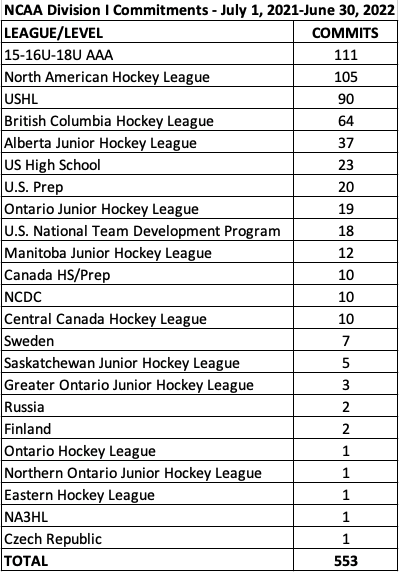The final NCAA Division I commitment numbers are in and the 15U-16U-18U AAA (commonly referred to as "Midgets") has taken the title, edging out the North American Hockey League which led the country the past two years.
The post-Covid shuffle definitely showed up in 2021-22 as the number of commitments jumped back up to 553 after a total of 405 last year. In 2019-20 there were 546. While these numbers don't translate into players actually matriculating to Division I rosters, they do count legitimate verbal commitments made by the schools and players and listed on the College Hockey Inc. website.
The changes that take place to some players making these commitments show up in the NCAA Division I Freshman Roster breakdown that the Junior Hockey Hub performs every year.
The 2020-21 season saw the glut of fifth-year Covid players returning to teams, many via the transfer portal, which meant far fewer actual roster spots available for matriculating Junior players. That led to the 25 percent decrease in commitments last year and it appears the player glut is shaking itself out sooner than the two or three years many predicted in 2021.
Below are the final results for the level at which each of the 553 players were competing when they made their Division I commitment.
As always, the JHH's disclaimer needs to be printed for all the USHL cheerleaders:
- Many USHL players enter that league with commitments already made. The JHH data does not indicate the USHL is NOT the best Junior hockey league in the United States or North America. On the contrary. It continually produces a high number of commitments and many already-committed players matriculate to the USHL.
- The U.S. National Team Development Program is not a franchise-owning program in the USHL, therefore is not counted as part of that league. If the USNTDP operated by the same standards as other USHL teams they would be counted in that league. Until then the USNTDP is its own entity.
This data is memorialized at the time of commitment whereas other tracking sources, like College Hockey Inc., update their data each time a player moves to a new team/league.
In the past three years the North American Hockey league still holds a 300-272 lead over the USHL, while the 15U-16U-18U AAA level comes in at 228, BCHL at 192 and U.S. High/School Prep (combined) are at 147.







